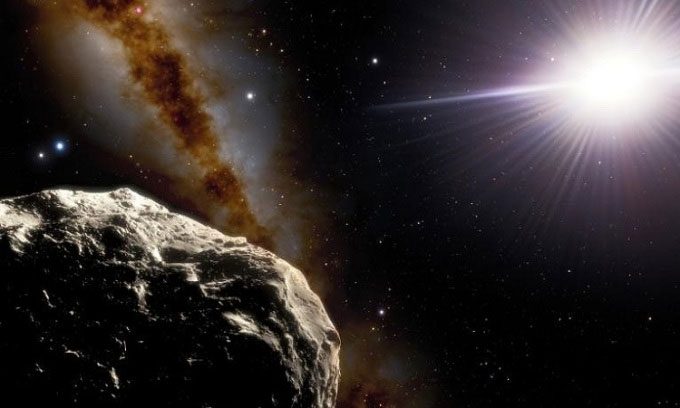The 1.3 km diameter Trojan asteroid will orbit the Sun alongside Earth at a safe distance.
Astronomers have observed the asteroid 2020 XL5 using the Southern Astrophysical Research Telescope in Chile. They announced the discovery of this Trojan asteroid on February 3 in the journal Nature Communications. Trojans are celestial bodies that share an orbit with a planet, located in one of two gravitationally stable regions along the planet’s orbit, known as Lagrange points, according to Cesar Briceño, a scientist at the Cerro Tololo Inter-American Observatory and a co-author of the study.

Simulation of a Trojan asteroid orbiting the Sun like Earth. (Image: SPA)
Lagrange points are regions of space where the gravitational forces of the Sun and one of the planets balance, according to Toni Santana-Ros, a researcher at the University of Alicante and the Institute of Space Sciences at the University of Barcelona. The stable orbit of Trojan asteroids makes them ideal candidates for future close-flyby missions.
Trojan asteroids are named after figures from Greek mythology and orbit the Sun along paths similar to those of planets such as Jupiter, Venus, Mars, Uranus, and Neptune. Jupiter has over 5,000 known Trojan asteroids that move ahead of and behind the giant gas planet. NASA’s recently launched Lucy mission is the first to explore several of Jupiter’s Trojan asteroids over a 12-year journey. 2020 XL5 is the larger of the two Trojan asteroids accompanying Earth, with a diameter of 1.2 km. The first Trojan asteroid, 2010 TK7, was discovered over a decade ago and is approximately three times smaller.
Astronomers first spotted the new Trojan asteroid on December 12, 2020, using the Pan-STARRS1 survey telescope in Hawai’i and continued observations with other telescopes. Initially, they thought it was a near-Earth asteroid passing through our planet’s orbit, but data from the SOAR telescope was compared with previous observations from the 4-meter Victor M. Blanco telescope in Chile from 2012 to 2019.
Data collected over nearly a decade allowed the research team to calculate the object’s orbit and confirm it as a Trojan asteroid. This object is expected to maintain its current orbit for the next 4,000 years before gravitational forces either eject it into space or send it into an elliptical orbit around the Sun. Researchers also identified it as a carbon-rich type C asteroid, the most common type in the solar system. The object likely originated from the main asteroid belt between Mars and Jupiter but was ejected due to Jupiter’s immense gravitational influence. However, scientists need to conduct further research to conclude the asteroid’s origins.
The astronomical community believes there may be many more Trojan asteroids accompanying Earth that remain undiscovered, but they are challenging to observe. Trojan asteroids always lie ahead of or behind a planet while orbiting the Sun. They are also very close to the Sun in the sky when viewed from Earth.
Observing Trojan asteroids can only be conducted close to dawn or dusk with telescopes pointed near the horizon. This allows telescopes to see through the thickest part of Earth’s atmosphere. The SOAR telescope can aim at an angle of 16 degrees above the horizon. As more satellites are launched into space, this may hinder astronomers from observing objects located above the horizon.





















































